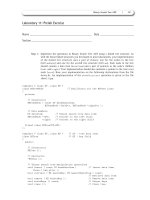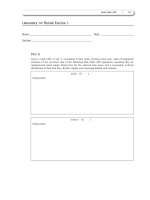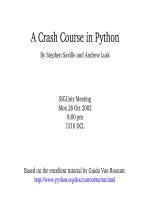IT training a short course in computational science and engineering c++, java and octave numerical programming with free software tools yevick 2012 07 09
Bạn đang xem bản rút gọn của tài liệu. Xem và tải ngay bản đầy đủ của tài liệu tại đây (2.04 MB, 280 trang )
A Short Course in Computational Science and Engineering
C++, Java and Octave Numerical Programming with Free
Software Tools
Building on his highly successful textbook on C++, David Yevick provides a
concise yet comprehensive one-stop course in three key programming
languages, C++, Java and Octave (a freeware alternative to MATLAB R ).
Employing only public-domain software to ensure straightforward
implementation for all readers, this book presents a unique overview of
numerical and programming techniques relevant to scientific programming,
including object-oriented programming, elementary and advanced topics in
numerical analysis, physical system modeling, scientific graphics, software
engineering and performance issues. Relevant features of each programming
language are illustrated with short, incisive examples, and the installation and
application of the software are described in detail. Compact, transparent code in
all three programming languages is applied to the fundamental equations of
quantum mechanics, electromagnetics, mechanics and statistical mechanics.
Uncommented versions of the code that can be immediately modified and
adapted are provided online for the more involved programs.
This compact, practical text is an invaluable introduction for students in all
undergraduate- and graduate-level courses in the physical sciences or
engineering that require numerical modeling, and is also a key reference for
instructors and scientific programmers.
D Y is a Professor of Physics at the University of Waterloo. He has
been engaged for 30 years in scientific programming in various fields of optical
communications and solid state physics at numerous university and industrial
establishments, where he performed pioneering work on the numerical
modeling of optical communication devices and systems. Professor Yevick is
currently a Fellow of the American Physical Society, the Institute of Electrical
and Electronics Engineers and the Optical Society of America as well as a
registered Professional Engineer (Ontario). He has taught scientific and
engineering programming for over 20 years and has authored or co-authored
over 170 refereed journal articles.
A Short Course in
Computational Science and
Engineering
C++, Java and Octave numerical
programming with free software tools
David Yevick
Cambridge, New York, Melbourne, Madrid, Cape Town,
Singapore, S˜ao Paulo, Delhi, Mexico City
Cambridge University Press
The Edinburgh Building, Cambridge CB2 8RU, UK
Published in the United States of America by Cambridge University Press, New York
www.cambridge.org
Information on this title: www.cambridge.org/9780521116817
David Yevick 2012
This publication is in copyright. Subject to statutory exception
and to the provisions of relevant collective licensing agreements,
no reproduction of any part may take place without the written
permission of Cambridge University Press.
First published 2012
Printed in the United Kingdom at the University Press, Cambridge
A catalogue record for this publication is available from the British Library
Library of Congress Cataloguing in Publication data
Yevick, David.
A short course in computational science and engineering : C++, Java, and
Octave numerical programming with free software tools / David Yevick.
p. cm.
Includes index.
ISBN 978-0-521-11681-7 (hardback)
1. Computer programming – Textbooks. 2. Computer science – Textbooks.
QA76.6.Y48 2012
005.1 – dc23
2011044368
ISBN 978-0-521-11681-7 Hardback
Additional resources for this publication at www.cambridge.org/yevick
Cambridge University Press has no responsibility for the persistence or
accuracy of URLs for external or third-party internet websites referred to
in this publication, and does not guarantee that any content on such
websites is, or will remain, accurate or appropriate.
I. Title.
Rabbi Yose ben Kisma said:
Once I was walking on the road,
when a certain man met me. He
greeted me and I returned his
greeting. He said to me, ‘Rabbi,
from what place are you?’ I
said to him, ‘I am from a great
city of scholars and sages.’ He
said to me, ‘Rabbi, would you
be willing to live with us in
our place? I would give you
thousands upon thousands of
golden dinars, precious stones
and pearls.’ I replied, ‘Even if
you were to give me all the silver and gold, precious stones
and pearls in the world, I would
dwell nowhere but in a place of
Torah.’ (Ethics of the Fathers 6:9)
Rabbi Jose, Kismas son,
¨
˚
berattade:
En gang
gick jag ut
¨
och vandrade, da˚ motte
mig
¨
¨
en manniska,
som halsade
mig,
¨
och jag besvarde hans halsning.
˚
Han sporde mig: Rabbi, varifran
¨ du, och jag svarde honom:
ar
˚ en stor stad, full av visa
Fran
¨ och skriftlarda.
¨
man
Da˚ sade han
till mig: Rabbi, om du vill bo hos
˚ stad, vill jag giva dig
oss i var
˚
tusen ganger
tusen guldmynt,
¨adelstenar och parlor.
¨
Jag sva˚
rade honom: Om du sa˚ gave
¨
mig all varldens
silver, guld,
¨
¨
adelstenar
och parlor,
skulle jag
¨
aldrig vilja bo pa˚ ett annat stalle
¨ dar
¨ Torahn har sin hemvist.
an
¨
˚ 6:9)
(Fadernas
Tankesprak
Contents
1 Introduction
1.1 Objective
1.2 Presentation
1.3 Programming languages
1.4 Language standards
1.5 Chapter summary
1.6 How to use this text
1.7 Additional and alternative software packages
page 1
1
1
2
3
4
4
4
2 Octave programming
2.1 Obtaining octave
2.2 Command summary
2.3 Logistic map
5
5
5
14
3 Installing and running the Dev-C++ programming
environment
3.1 Compiling and running a first program
3.2 The Dev-C++ debugger
3.3 Installing DISLIN
3.4 A first graphics program
3.5 The help system
3.6 Example
15
15
17
19
19
20
20
4 Introduction to computer and software architecture
4.1 Computational methods
4.2 Hardware architecture
4.3 Software architecture
4.4 The operating system and application software
22
22
23
24
25
5 Fundamental concepts
5.1 Overview of program structure
5.2 Tokens, names and keywords
26
26
26
vii
viii
Contents
5.3
5.4
5.5
5.6
5.7
5.8
5.9
5.10
5.11
5.12
Expressions and statements
Constants, variables and identifiers
Constant and variable types
Block structure
Declarations, definitions and scope
rvalues and lvalues
Operators – precedence and associativity
The const keyword
Formatting conventions
Comments
6 Procedural programming basics
6.1 Scientific software development
6.2 The main( ) function
6.3 Namespaces
6.4 Preprocessor directives and
#include statements
6.5 Arithmetic and logical operators
6.6 The bool and enum types
6.7 Control flow, if statements and implicit
blocks
6.8 The for statement
6.9 while and do . . . while statements
6.10 The break, continue and
exit( ) statements
6.11 The typedef keyword
6.12 Input and output streams
6.13 File streams
6.14 Casts
6.15 Functions
6.16 Principles of function operation
6.17 Function declarations and prototypes
6.18 Enumerators and functions
6.19 Overloading and argument conversion
6.20 Built-in functions and header files
6.21 The assert statement and try and
catch blocks
6.22 Multiple return statements
6.23 Default parameters
6.24 Functions and global variables
6.25 Inline functions
6.26 Recursive functions
6.27 Modular programming
27
27
27
30
31
31
31
32
33
33
35
35
36
37
38
39
40
40
42
42
43
44
44
45
45
46
46
48
48
48
49
50
51
52
52
53
53
54
Contents
6.28 Arrays
6.29 Program errors
6.30 Numerical errors with floating-point types
54
55
56
7 An introduction to object-oriented analysis
7.1 Procedural versus object-oriented programming
7.2 Problem definition
7.3 Requirements specification
7.4 UML diagrams
7.5 Classes and objects
7.6 Object discovery
7.7 Inheritance
58
58
60
61
61
61
63
65
8 C++ object-oriented programming syntax
8.1 Class declaration
8.2 Class definition and member functions
8.3 Object creation and polymorphism
8.4 Information hiding
8.5 Constructors
8.6 Examples
8.7 Wrappering legacy code
8.8 Inheritance
8.9 The “protected” keyword
8.10 Multifile programs
8.11 const member functions
66
66
66
68
70
71
73
75
76
78
78
81
9 Arrays and matrices
9.1 Data structures and arrays
9.2 Array definition and initialization
9.3 Array manipulation and memory access
9.4 Arrays as function parameters
9.5 Returning arrays as objects and object arrays
9.6 const arrays
9.7 Multidimensional arrays
9.8 Multidimensional array storage and loop order
9.9 Multidimensional arrays as function arguments
83
83
83
84
86
87
88
89
90
91
10 Input and output streams
10.1 The iostream class and stream manipulators
10.2 File streams
10.3 The string class and string streams
10.4 The toString( ) class member
10.5 The printf function
93
93
95
97
98
99
ix
x
Contents
11 References
11.1 Basic properties
11.2 References as function arguments
11.3 Reference member variables
11.4 const reference variables
11.5 Reference return values
101
101
102
103
103
104
12 Pointers and dynamic memory allocation
12.1 Introduction to pointers
12.2 Initializing pointer variables
12.3 The address-of and dereferencing operators
12.4 Uninitialized pointer errors
12.5 The const keyword and pointers
12.6 Pointer arithmetic
12.7 Pointers and arrays
12.8 Pointer comparisons
12.9 Pointers to pointers and matrices
12.10 String manipulation
12.11 Static and dynamic memory allocation
12.12 Memory leaks
12.13 Dangling pointers
12.14 Pointers in function blocks
12.15 Dynamic memory allocation within functions
12.16 Dynamically allocated matrices
12.17 Dynamically allocated matrices as function arguments
12.18 Pointer data structures and linked lists
106
106
107
107
108
109
110
110
111
111
112
113
115
115
117
118
119
120
121
13 Memory management
13.1 The this pointer
13.2 The friend keyword
13.3 Operators
13.4 Destructors
13.5 Assignment operators
13.6 Copy constructors
123
123
124
125
127
128
130
14 The static keyword, multiple and virtual inheritance,
templates and the STL
14.1 Static variables
14.2 Static class members
14.3 Virtual functions
14.4 Heterogeneous object collections and runtime type
identification
14.5 Abstract base classes and interfaces
132
132
132
134
135
136
Contents
14.6
14.7
14.8
14.9
14.10
14.11
14.12
14.13
14.14
14.15
Multiple inheritance
Virtual inheritance
User-defined conversions
Function templates
Templates and classes
The complex class
The standard template library
Structures, unions and nested classes
Bit-fields and operators
Program optimization
137
138
138
139
140
142
143
147
148
149
15 Creating a Java development environment
15.1 Basic setup
15.2 Command-line operation
15.3 A first graphical Java program
15.4 DISLIN applet
15.5 Graphics applet
15.6 Packages
15.7 Static (instance) and class members
152
152
153
155
155
156
157
159
16 Basic Java programming constructs
16.1 Comments
16.2 Primitive types
16.3 Conversions
16.4 Operators
16.5 Control logic
16.6 Enumerations
161
161
161
163
164
165
167
17 Java classes and objects
17.1 Class definition
17.2 Inheritance
17.3 Java references and functions
17.4 Exceptions
17.5 Basic Java reference types
17.6 Input and ouput
17.7 File I/O
168
168
170
171
173
174
177
178
18 Advanced Java features
18.1 Dynamic method dispatch
18.2 Abstract classes
18.3 Interfaces
18.4 Java event handling
18.5 Multithreading
179
179
180
180
182
184
xi
xii
Contents
18.6 Serialization
18.7 Generic types
186
186
19 Introductory numerical analysis
19.1 The derivative operator
19.2 Error dependence
19.3 Graphical error analysis
19.4 Analytic error analysis – higher-order methods
19.5 Extrapolation
19.6 The derivative calculator class
19.7 Integration
19.8 Root-finding procedures
19.9 Minimization
188
188
190
190
192
193
193
194
196
198
20 Linear algebra
20.1 Matrices
20.2 Linear-equation solvers
20.3 Errors and condition numbers
20.4 Application: least-squares procedure
20.5 Eigenvalues and iterative eigenvalue solvers
200
200
200
204
204
206
21 Fourier transforms
208
22 Differential equations
22.1 Euler’s method
22.2 Error analysis
22.3 The Runge–Kutta procedure
212
212
214
216
23 Monte Carlo methods
23.1 Monte Carlo integration
23.2 Monte Carlo evaluation of distribution functions
23.3 Importance sampling
23.4 The Metropolis algorithm
23.5 Multicanonical methods
23.6 Particle simulations
23.7 The Ising model
218
218
219
220
221
224
225
227
24 Partial differential equations
24.1 Scientific applications
24.2 Direct solution methods
24.3 Hyperbolic differential equations and electromagnetics
24.4 Elliptic equations
24.5 Split-operator methods for parabolic differential equations
230
230
234
235
240
242
Contents
24.6
24.7
24.8
24.9
Index
Symplectic evolution operators in classical mechanics
Fast Fourier transform methods in optics
The Crank–Nicholson method in quantum mechanics
Finite-difference and finite-element procedures
245
246
252
254
259
xiii
Chapter 1
Introduction
Soon after the publication of my C++ textbook, A First Course in Computational
Science and Object-Oriented Programming with C++, in 2005, I conceived of
including a yet more compact introduction to C++ in a survey of the entire field
of scientific programming. Drawing on 20 years of experience of teaching programming at all levels in both physics and electrical engineering departments,
I resolved to both summarize my previous treatment of C++ and incorporate
a discussion of the Octave and Java programming languages, focusing on their
conceptual foundations. Finally, I would insert many additional scientific programming examples, emphasizing short programs that illustrate key algorithms.
By employing only free software, this would create a uniquely comprehensive
treatment of the full set of steps from compiler installation to sophisticated
scientific programming.
1.1 Objective
This textbook overviews modern scientific programming, including numerical
analysis, object-oriented programming, scientific graphics, software engineering, numerical analysis and physical system modeling. Consequently, knowledge of the material will provide sufficient background to enable the reader
to analyze and solve nearly all normally encountered scientific programming
tasks.
1.2 Presentation
The text is concise, focusing on essential concepts. Examples are intentionally short and free of extraneous features. To promote retention, the book
repeats key topics in cycles of gradually increasing difficulty. Further, since
the process of learning computer language shares many similarities with that of
acquiring a spoken language, important code is highlighted in gray. Memorizing these features greatly decreases the time required to achieve proficiency in
programming.
1
2
Introduction
1.3 Programming languages
Computing paradigms have evolved with time from the implementation of individual operations within a computing device to high-level structures that closely
resemble interactions of physical objects with their environment. These concepts
have simultaneously been realized through languages that have progressed from
machine language to procedural, object-oriented and visual programming.
General-purpose procedural languages. A procedural language is composed
of a structured sequence of commands, which may be further organized into
modules termed functions or subroutines. A program implements a series of
commands that are sequenced through logical statements. This strategy yields
languages that are easily learned and applied. Especially early procedural languages such as FORTRAN, however, contain numerous unsafe constructs that
invariably lead to coding errors.
Scientific procedural languages. To simplify small proof-of-principle computations, specialized scientific languages such as MATLAB R and Octave and
symbolic manipulation languages such as MAPLE R or Mathematica R provide
an easily learned high-level user interface to a unified built-in array of easily
called and highly optimized numerical, scientific and graphical libraries. MATLAB code can be transformed into C++ through an add-on product while C++
and FORTRAN routines can be called by a MATLAB program with some effort.
Additionally, MATLAB and similar programs originate from a single commercial
source and therefore function nearly identically across all supported platforms
(running the same version number). However, the suppression of advanced features such as classes, type-checking and user-controlled memory management
can lead to structural confusion, programming errors and runtime inefficiency
for larger problems. Further, the software is unavailable at many sites because
of its substantial cost, although this can, however, increasingly be circumvented,
through free software packages that imitate MATLAB commands. This textbook
accordingly employs the most widely employed alternative, GNU Octave.
Object-oriented languages. The fundamental high-level unit in modern programming languages is an object. An object is a simplified model or abstraction
of a particular entity. To illustrate, consider for definiteness a voltage meter. The
meter has many attributes – in the extreme case the position and velocity of each
atom – but only a few of these are typically of interest. These relevant attributes,
which could include both user-accessible, public, data and behaviors, such as
the voltage reading and the meter’s response to depressing the power-on switch,
and inaccessible, private, characteristics, such as the currents through individual
circuit elements, compose the relevant abstraction of the object. By analogy, in
a C++ program, public properties can be accessed throughout the code while
private members are accessible only to functions that exist within the object
itself, restricting the associated code region subject to inadvertent errors.
In an object-oriented language, objects with similar properties are described
by a class. Two functions or variables with the same name that belong to different
1.4 C++ standards
classes are considered to be unrelated, circumventing name collisions. A class
can incorporate the features of a second class by inheriting its non-private
properties; the new, derived, class can then employ or redefine the properties
of the original, base, class without recoding. Refinements to the original class
automatically propagate to the new class.
Since additional programming syntax is required in order to create and manipulate objects and classes, object-oriented languages require more time to learn
than procedural languages. However, the structure of the resulting program
closely represents the physical objects that are being modeled. Accordingly,
object-oriented development is advisable for large programs or programs that
will be frequently revised.
The C++ language. C++, which extended the preexisting C procedural programming language, constituted the first widespread object-oriented language.
Numerous scientific programming packages are at present available in C++,
while FORTRAN programs can be, with some effort, accessed from C++, c.f.
Appendix D of my companion textbook A First Course in Computational Science
and Object-Oriented Programming with C++. However, the additional functionality of C++ enables manipulations that can introduce unexpected dependences among variables. To ascertain these dependences, C++ typically runs
more slowly than FORTRAN, although advanced C++ language features can
be employed to circumvent these difficulties, as discussed in Chapter 21 of the
above reference.
Java: As a more recent object-oriented language, Java provides a far broader
standard feature set than C++. Classes that e.g. handle graphics and internet communications are native to the language and in principle function identically across
all Java implementations (although, in reality, version and machine dependences
exist). Modern programming features such as multithreading and object serialization are additionally included. However, since the language is oriented toward
the corporate market, many design choices are unfavorable for sophisticated scientific programming. For example, C and C++ contain high-level commands
that enable direct access to hardware resources. These include addressing and
modifying the contents of individual memory locations and precisely allocating
and releasing the memory available to a program during execution. Since severe
errors result if such manipulations are improperly performed, Java handles such
operations automatically, at the cost of longer or unpredictable execution times.
Further, extensive mathematical or scientific program libraries are ported only
very slowly, if at all, to new programming languages.
1.4 Language standards
As requirements evolve, programming languages undergo periodic revision by
a standards organization. For relatively new languages such as Java, revisions
can be significant; further, existing language elements can become deprecated
(unsupported) and eventually obsolete. In contrast, revisions to mature languages
3
4
Introduction
such as C++ are relatively minor and do not affect core functionality. However,
programs employing elements of a new standard will not necessarily function on
older compilers.
1.5 Chapter summary
The organization of this book is as follows. After a short introduction to Octave
in Chapter 2, the following chapters summarize the installation of a free C++
programming environment, computer hardware and software architecture and
the basic structure and syntax of the C++ language. Chapter 7 introduces objectoriented programming in C++, with more advanced features of C++ following in
Chapters 9–14. Chapters 15–17 discuss basic Java programming, with advanced
Java features relegated to Chapter 18. Chapters 19–24 finally discuss applied
numerical analysis in the context of numerous physical and engineering applications, including mechanics, electromagnetism, statistical mechanics, quantum
mechanics and optics.
1.6 How to use this text
The reader is encouraged to follow the steps below.
(1) Skim through the text.
(2) Reread the chapter, programming and running as many sample programs in the text
as possible. Attempt, if possible, to extend these programs.
(3) Memorize the programs or program sections marked in gray in the text. Success in
programming is largely dependent on being able to recall instantly central language
features.
1.7 Additional and alternative software packages
While comprehensive freeware and commercial C++ and Java numerical
libraries exist, such as the GNU, CERN, IMSL and NAG libraries, such routines are typically designed for a restricted set of hardware and software platforms. Therefore, for smaller programs well-documented source code such as
the programs in this book will often provide a more optimal trade-off between
computational efficiency and development time.
Chapter 2
Octave programming
For small programs or rapid prototyping of ideas and methods, the commercial
MATLAB R language, or its freeware alternatives, offers a practical alternative
to C++ or FORTRAN. In this book, the free GNU Octave implementation is
discussed from a scientific programming perspective. After becoming familiar
with the central language constructs summarized below, the built-in Octave help
facilities conveniently provide information on specialized, infrequent commands.
2.1 Obtaining octave
The Windows and Mac installation packages for GNU Octave are currently
located at octave.sourceforge.net. Linux versions are available at the main Octave
web site www.gnu.org/software/octave. When the program is installed, a variety of
additional packages and the creation of a database of C++ components accessible
by the editor can be selected. Unless space is an issue, these options should be
chosen.
2.2 Command summary
(1) Running Octave. After clicking on the Octave icon, statements are entered interactively by typing into the resulting command window at the > prompt. An Octave
session is terminated by typing quit.
(2) System commands. To change from the startup directory (folder) to the directory that either contains or will contain program files, type cd X:\dir1\dir2\ . . .
\programDirectory, where X is the partition (logical drive) containing the desired
directory and \dir1\dir2 . . . \programDirectory is an ordered sequence of the
names of the directories enclosing the directory, \programDirectory, in which the
program is located. If one or more directory names contain spaces, the entire expression containing these names must be surrounded by double apostrophes ("), e.g.
cd "X:\My Documents". Representative operating-system commands that can be
issued from the Octave prompt include mkdir directoryName, which creates the
directory directoryName, rmdir directoryName, which removes this directory,
5
6
Octave programming
(3)
(4)
(5)
(6)
(7)
(8)
dir or ls, which display the contents of a directory, .., which moves to one directory
higher in the directory tree, ., which represents the current directory, rename file1.1
file2.2, which renames the file file1.1 to the name file2.2, and copy, which similarly
copies a file.
MS-DOS and Unix commands. Standard DOS commands on Windows systems and
Unix commands on Unix systems are issued in Octave by typing e.g. dos 'copy file.1
file.2' or, on a Unix system, unix 'cp file.1 file.2' (single or double apostrophe). In
MATLAB such commands can also be preceded with !.
Command structure and continuation lines. Octave commands end at a carriage
return, comma or semicolon; however, only a semicolon suppresses the output of
the statement from being written to the terminal. Two or more commands situated
on the same line must be separated by commas or semicolons. A statement can
span several lines but each line must normally be terminated by a three-period
continuation character, . . . .
Creating and editing files. The command diary on stores subsequent commands
entered from the keyboard in a file named diary until diary off is issued. To examine
this file or to create or edit an Octave program, after navigating to the directory in
which the file resides, type edit at the command prompt, followed, where applicable,
by the name of the file to be edited or created.
Comments. Any text to the right of a comment character, %, constitutes a comment
and is consequently ignored by the Octave interpreter. The beginning of a program
should contain the date, version number, title and author. Every set of statements
(a paragraph) performing a certain task should be preceeded by one or more blank
lines followed by comment lines explaining the purpose of the program unit. When
a variable is introduced, its meaning should be made clear by a comment either
above the line or on the same line to the right of the statement. Such annotations
insure the long-term readability of programs.
Using help. To find and implement rarely employed commands, type first lookfor
subject to obtain a list of all commands involving the operation ‘subject’. Issuing
help commandName (or doc commandName) then provides help on the command
commandName.
Octave programs. Octave program and function files must possess a .m extension;
that is, to program in Octave, first type edit from within the Octave command
window and create a file such as
S = 2;
S * . . . % Illustrates the comment and continuation symbols
S
Then, when saving the file, specify test in the "File Name" text entry field while in
the "Save File as Type" drop-down text box select MATrix LABoratory (.m). This
automatically appends the correct .m extension to the file name. If the file is saved in
a directory, e.g. X:\testDirectory, then, at the Octave prompt, type cd followed by
the directory (including, if necessary, the partition name, e.g. cd X:\testDirectory)
2.2. Command summary
(9)
(10)
(11)
(12)
(13)
(14)
where test.m resides, press enter and then type test. The program test can also be
called from within another .m file within the same directory.
Variable-naming conventions. For clarity, variable names should start with a small
letter, while subsequent words in the name should be capitalized, e.g. numberOfPoints. However, in Octave a name can represent an array of any size and number
of dimensions, which can result in subtle errors. To prevent this, quantities with a
row dimension can be indicated by a trailing R, those with a column dimension as
C and a matrix with a trailing RC, e.g, systemMatrixRC. If matrices with different
dimensions are present, the row and column sizes can be further specified as in
systemMatrixR4C8. Since Octave is not a typechecked language, the above conventions can still lead to severe and difficult-to-locate errors for some compound
words such as wavefunction, which can be treated as one word in certain places
and as two words (waveFunction) in others. Typing a single character incorrectly
generates similar problems. These errors, however, can be immediately identified
by typing who at the command line, which displays a list of all the currently defined
variables. Any spelling error will then be evidenced by a variable name seemingly
appearing twice in the list.
Formatting conventions. Every binary operator (+, − etc.) should be surrounded
by spaces, but not unary operators as in 3 + −4.0. Indentation should be employed
for every set of statements that are under the logical control of a control statement
such as for, if, while. Commas, semicolons, parentheses and braces should, where
appropriate, be followed by spaces.
Program input. To prompt the user from within a .m file to enter a single variable
or array x from the keyboard, employ x = input( 'user prompt ' ). A variable y that
can later be employed in a logical control statement to branch into different program
units is conveniently entered with y = menu( 'Select the method', 'Method A',
'Method B', 'Method C' ); which assigns the value 1, 2 or 3 to y according to the
user selection.
Output formatting. The more command pages subsequent output. To write out
subsequent floating-point output with 16 digits of precision, type in format long
e, to revert to the default 5 digits, type format short e or, equivalently, format
compact.
Built-in constants and functions. Important predefined scalar quantities are e, pi,
i and j, both of which represent the unit complex number, and eps, the smallest
number which when added to 1 gives a number different from 1 (machine epsilon).
However, a major problem arises if these variables are redefined, for example, the
command i = [1, 3] overwrites the intrinsic definition of i, which is not reinstated
until a further command clear i is issued. Note that i and j are frequently employed
as loop variables, so that all loop variables should instead be labeled, for example,
loop, innerLoop, outerLoop.
Complex numbers. A complex number is introduced as c = 2.0 + 4.0i and then
manipulated with functions such as real( ), imag( ), conj( ), norm( ). Complex
numbers are e.g. multiplied, divided and exponentiated in standard fashion either
7
8
Octave programming
by real or by other complex numbers. Functions such as cos( ), sin( ), sinh( ) yield
complex results when applied to complex quantities.
(15) Loading arrays. A variable name can represent a scalar or an array of any dimension.
A row vector is introduced as
vR = [1 2 3 4];
or
vR = [1, 2, 3, 4];
while a column vector is entered, even from the keyboard, as
vC = [1
2
3
4];
or, equivalently (since a semicolon is largely equivalent to a carriage return),
vC = [1; 2; 3; 4];
With the transpose operator .' the above column vector can also be entered as
vC = [1 2 3 4].';
A matrix
m RC =
1
3
2
4
can therefore be entered in any of the following ways:
mRC = [1 2; 3 4];
mRC = [1 2
3 4];
vR = [1 3 2 4]; mRC = reshape( vR, 2, 2 );
vC = [1
3
2
4]; mRC = reshape( vC, 2, 2 );
(The order in which a vector is reshaped indicates that matrix elements with successive values of the leftmost, column, index are stored next to each other in memory.)
The matrix element (mRC)12 is subsequently accessed by mRC(1, 2). Since scalars
and arrays are manipulated identically, arrays with multiple dimensions are constructed from component vectors or from subarrays in the same manner as from
scalar quantities, e.g. vR4 = [[1 2] [1 2]] yields [1 2 1 2];, while mBlockRC = [mRC
mRC; mRC mRC]; is a matrix of twice the dimension of mRC. While a vector
or matrix expands dynamically as new elements are added as in vR = [1 2]; vR(3)
= 3; this is computationally inefficient and memory should instead be preallocated
through a statement such as vR = zeros( 1, n ), which creates a row vector of n zero
elements.
2.2. Command summary
(16) Size and length. Octave maintains a record of the size of an array to prevent element
access outside this range. Hence mRC(1, 3) yields an error if mRC is a 2 × 2 matrix.
The command size( mRC ) for an M × N matrix returns the array [M, N]. For a
single-dimension array, length( vR ) returns the length of the array vR. However,
when applied to a two-dimensionsal array length( mRC ) returns the maximum
value of M and N, possibly leading to unexpected errors.
(17) Matrix operations. The n × n identity matrix is represented by eye( n ) or eye( n, n ),
while the n × n matrix with all unity elements is denoted ones( n ) or ones( n, n ).
If s = 2 and mRC = [1 2; 3 4] as in item (15) above, then
3
5
s + mRC = s ∗ ones (2,2) + mRC ⇒
4
6
while
s ∗ eye (2, 2) + mRC ⇒
3
3
2
6
Very often, errors arise because of failure to differentiate between these. Multiplication similarly possesses different meanings depending on variable type. Multiplying
or dividing a matrix mRC by a scalar s multiplies (divides) all elements of mRC
by s while mRC * mRC symbolizes normal matrix multiplication and
mRC. ∗ mRC ⇒
1
9
4
16
implements component-by-component multiplication. Similarly mRCˆ2 is mRC
* mRC, while mRC.ˆ2 instead squares the individual elements of mRC. The
dot operator functions analogously for other arithmetic operations such as mRC
./ nRC, which yields a matrix whose (i, j)th element is simply (mRC)ij /(nRC)ij .
Standard functions such as cos( mRC ) operate on the individual elements of mRC,
here returning the matrix formed by taking the cosine of each element. Two easily
confused operations are array (matrix) transpose without complex conjugation, .',
and transpose with complex conjugation, '. Note that the simpler syntax is applied to
the Hermitian conjugate operation, since this yields the standard norm of complex
(as well as real) arrays. For a vector vR = [1, 2] with elements (vR)ij , the dot or inner
product without complex conjugation is given by vR * vR.', while the (Kronecker)
outer product vR.' * vR yields the 2 × 2 matrix with (i, j)th element (vR)i (vR)j ,
namely [1 2; 2 4].
(18) Matrix functions. A few functions ending in the letter m such as the matrix exponential expm act on matrix arguments and are defined (although not implemented)
through power-series expansions such as
expm( aRC ) = eye( size( aRC ) ) + aRC + aRCˆ2/2!
+ aRCˆ3/3! + ...
The determinant, trace, inverse, logarithm and square root of aRC are similarly
given by det( aRC ), trace( aRC ), inv( aRC ), logm( aRC ) and sqrtm( aRC ),
9
10
Octave programming
(19)
(20)
(21)
(22)
(23)
respectively. The LU decomposition of aRC is expressed as [lRC, uRC] = lu(aRC);.
The eigenvalues, arranged in ascending order, and the corresponding eigenvectors
of a matrix aRC are placed, respectively, in the columns of the matrix mVecRC
and the diagonal elements of mValRC through the call [mVecRC, mValRC] =
eig( aRC );. Simply calling eig( aRC ) returns a vector containing the eigenvalues
in ascending order.
Solving linear equation systems. The quotient of two matrices in Octave written as
mRC / nRC denotes mRC * inv( nRC ), while mRC \ nRC instead represents
inv( mRC ) * nRC. Accordingly, the linear equation system xR * mRC = yR is
solved by xR = yR / mRC, while xC =mRC \ yC if mRC * xC = yC.
Sparse matrices. Operations on matrices with few non-zero elements are accelerated
if the matrices are implemented as sparse matrices. The simplest procedure converts
a full matrix aRC to a sparse matrix by bRCsp = sparse( aRC ) (which is reversed
with aRC = full( bRCsp ) ). Subsequent operations such as * and / are performed
with sparse routines if all operands or arguments are sparse (except for an identity
or zero matrix). spy( mRCsp ) displays the locations of the non-zero elements of
mRCsp while speye( n ) is an n × n sparse identity matrix.
Random-number generation. To compare the different versions of a program that
incorporates a random-number generator, the random sequence should be the same
in all versions. This is accomplished by introducing the statement rand( 'state', 0 )
at the beginning of each program. Uniformly distributed random numbers between
0 and 1 are generated singly with rand or as a multidimensional array with e.g.
rand( m, n ). Typing lookfor rand displays information about functions for other
random distributions.
Saving variables. A variable v is stored in the text Octave file filename through
save filename v and then recovered through load filename. This file can then be
inspected or edited with any text editor. All variables present in the workspace
are simultaneously saved and loaded in through the commands save filename
and load filename. [In MATLAB the save command instead writes to a binary
file filename.mat and will only save a variable v to an ASCII file vdata if the
command save vascii v –ascii is instead employed. The variable is in this case
recovered from the .mat file with load vascii; v = vascii; where only the first
statement is employed if v is employed for the file name in place of vascii.
However, retrieval from MATLAB binary files that store more than one variable
presents difficulties since the original variable names are not stored as in .mat
files.]
String manipulation. A string such as s = 'test' is stored as an array ['t' 'e' 's' 't']
of characters so that s(1) returns t and ['a ', s] yields the new string 'a test'. Integers and floating-point numbers are translated into strings through the functions
int2str( ) and num2str( ), respectively; the reverse operation is performed by
str2int( ) and str2num( ). An Octave expression, expressed as a string, is sent
to the command processor by writing eval( ); as an example, to display the files
present in the directory, the commands s = 'dir'; eval( s ); can be employed.









